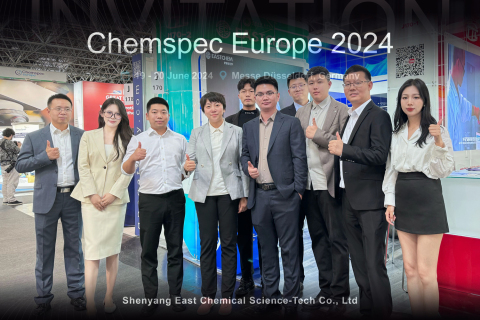
- Home
- >
News
From June 19th to 20th, the 37th International Fine and Specialty Chemicals Exhibition was held at the Düsseldorf Exhibition Center in Germany, attracting representatives from the global chemical and materials industries. As a company focusing on chemicals and materials, East Chemicals showcased its unique solutions at the exhibition with high-performance chemicals and advanced materials as its main line.
Hydroxypropyl methyl cellulose is a synthetic polymer made from natural cellulose through chemical modification. Cellulose ether is a derivative of natural cellulose. The production of cellulose ether is different from synthetic polymers. Its most basic material is cellulose, a natural polymer compound. Due to the special structure of natural cellulose, cellulose itself has no ability to react with etherifying agents. However, after treatment with the swelling agent, the strong hydrogen bonds between and within the molecular chains are destroyed, and the active release of the hydroxyl group becomes alkali cellulose with the ability to react. After the reaction of the etherifying agent, the -OH group is converted into the -OR group. Cellulose ether is obtained.
CPhI North America 2024 will be held in Philadelphia, USA from May 07-09. As the world's top professional exhibition for the pharmaceutical industry, CPHI North America is the only pharmaceutical industry event in the United States that covers the entire industry chain including drug research and development, production, and packaging.
On April 29, the three-day 16th Chongqing International Battery Technology Forum/Exhibition (CIBF2024) concluded successfully at the Chongqing International Expo Center. During this period, East Chemical shined at the venue with its hard-core products, providing one-stop solutions for chemical raw material manufacturers.
1. Cement mortar: improve the dispersion of cement sand, greatly improve the plasticity and water retention of mortar, have an effect on preventing cracks and enhance the strength of cement.
HPMC is a non-ionic cellulose ether polymer, which has different chemical properties according to the degree of substitution of the substituent groups and the degree of modification. It is a non-ionic, odorless, odorless white fiber Pure ether powder.
Gypsum mortar is a building material with gypsum as the main component. Gypsum accounts for 70% to 80% of the total weight of the mortar. Other components include lime, silicate, etc. The following is a summary of the effects of several mortar additives on gypsum mortar.
(1) Whiteness: Although whiteness cannot determine whether HPMC is easy to use, and if whitening agent is added in the production process, its quality will be affected. However, most good products have good whiteness.
Hydroxypropyl methyl cellulose plays three roles in the putty powder: thickening, water retention and construction.
According to different uses and performance requirements, you can refer to the recommended ratio according to the product manual and configure it as needed.
HPMC is divided into two types: instant type and hot melt type. The instant type disperses quickly in cold water and initially has no viscosity because the HPMC is only dispersed in the water without actually being dissolved. After about 2 minutes, the liquid gradually thickens and forms a transparent, viscous colloid. Hot-melt products will appear agglomerated in cold water, but will disperse quickly in hot water until the temperature drops to a certain level and the viscosity will gradually increase to form a transparent and viscous colloid. The hot-melt type is mainly used for putty powder and mortar. It may cause lumps in liquid glue and paint, so it is not suitable. The instant type is more widely used and can be used for putty powder, mortar, liquid glue and coatings without specific restrictions.












